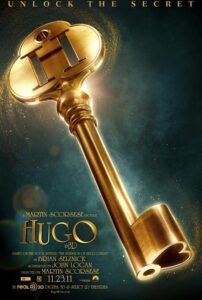
 With the best use of 3D in a dramatic feature I’ve seen to date, the great Martin Scorsese’s “Hugo” will make many filmmakers consider the format for their next film. But the story falls short of the lovely visuals.
With the best use of 3D in a dramatic feature I’ve seen to date, the great Martin Scorsese’s “Hugo” will make many filmmakers consider the format for their next film. But the story falls short of the lovely visuals.
Had Scorsese wanted to make a bio-pic about filmmaker Georges Méliès, he probably should have taken a more traditional approach. The pioneering French director, Méliès made over 500 films experimenting and successfully creating techniques that today we take for granted. His “A Trip to the Moon” from 1902 is one of Méliès’ best known works and influenced every filmmaker thereafter. And his personal story certainly could make a terrific stand alone feature. Key to understanding “Hugo” is knowing a bit of Méliès’ history. Although he made over 500 films and was one of his era’s most successful directors, he reportedly ended his life in poverty.
Onto this biographic backdrop, Scorsese tries to craft a family adventure film in 3D from a script by John Logan (who he worked with on “The Aviator”). The script itself is adapted from a children’s book by Brian Selznick. The effect of all that talent is summed up by one of the characters in “Hugo” played extremely well by Chloë Grace Moretz. The character, Isabelle, chastises titular hero Hugo Cabret (Asa Butterfield) about being enigmatic, and she says something to the effect that such mystery doesn’t become him. And it is precisely the mystery that fails the story in “Hugo.” Played broadly with layers of endless flashback and lengthy exposition, not one eventual revelation surprises us. “Hugo” becomes coldly academic appealing more to cineastes and filmmakers than to its key family demographic.
The story should have been more fun. It is after all about a little boy named Hugo who has lost his parents and goes to work with his alcoholic uncle in a train station where he maintains several complicated clocks. And for a while it is fun as the camera twists and turns through the walls of the station following the scurrying Hugo as he goes about his daily routine. But the routine quickly become tiresome even as he spies on people from behind the clock faces. The fact that the images are so finely cut with stunning detail helps keep viewers engaged but the pretty pictures aren’t enough to carry the film.
In time, Hugo develops a friendship with the inquisitive Isabelle who has also lost her parents and lives with her grandparents. The two explore the station together and eventually discover the key to a rare automaton (clockwork robot) that may hide a message that will change their lives. The key mysteries involve why Isabelle’s grandfather (played by Ben Kingsley) is so sad and what message the automaton holds. Unfortunately, the unraveling is less than impactful and left me a little hallow.
Of note is “Borat’s” Sacha Baron Cohen delivering a little slapstick as the station inspector. But instead of his antics coming out of the Buster Keaton school they feel very flat and even routine. In one sequence, the inspector chases Hugo into a café and crashes into a cello smashing it senselessly to pieces. Such destruction isn’t funny and served no comedic purpose. It was just destructive. What was revealing to me was the laugh from the audience when a critical scene from Keaton’s own 1926 classic “The General” flashed on the screen. I was surprised that Scorsese did not pick up on how flat Cohen is most of the time. Only later is part of his character’s painful backstory revealed and, thankfully, we are spared another frustrating flashback.
But it’s not all bad news. If you are into the history of filmmaking, “Hugo” might enchant you. And if you’ve yet to be smitten with 3D, this film will go a long way to promote the format. From what I’ve heard, Scorsese’s contemporary Francis Ford Coppola toyed around with 3D with less than stellar results in his quasi-horror film “Twixt” that might have a hard time seeing theaters. Scorsese proves that there is merit to the format, especially in a movie that celebrates the work of a great filmmaking pioneer. But every filmmaker worth his salt knows that image is secondary to telling a good story. And Scorsese, one the best directors of all time, well knows this, and he probably also knows that his “Hugo” is a triumph of form over substance.
